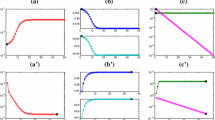Summary.
The ``L--curve'' is a plot (in ordinary or doubly--logarithmic scale) of the norm of (Tikhonov--) regularized solutions of an ill--posed problem versus the norm of the residuals. We show that the popular criterion of choosing the parameter corresponding to the point with maximal curvature of the L--curve does not yield a convergent regularization strategy to solve the ill--posed problem. Nevertheless, the L--curve can be used to compute the regularization parameters produced by Morozov's discrepancy principle and by an order--optimal variant of the discrepancy principle proposed by Engl and Gfrerer in an alternate way.
Similar content being viewed by others
Author information
Authors and Affiliations
Additional information
Received June 29, 1993 / Revised version received February 2, 1994
Rights and permissions
About this article
Cite this article
Engl, H., Grever, W. Using the L--curve for determining optimal regularization parameters . Numer. Math. 69, 25–31 (1994). https://doi.org/10.1007/s002110050078
Issue Date:
DOI: https://doi.org/10.1007/s002110050078



